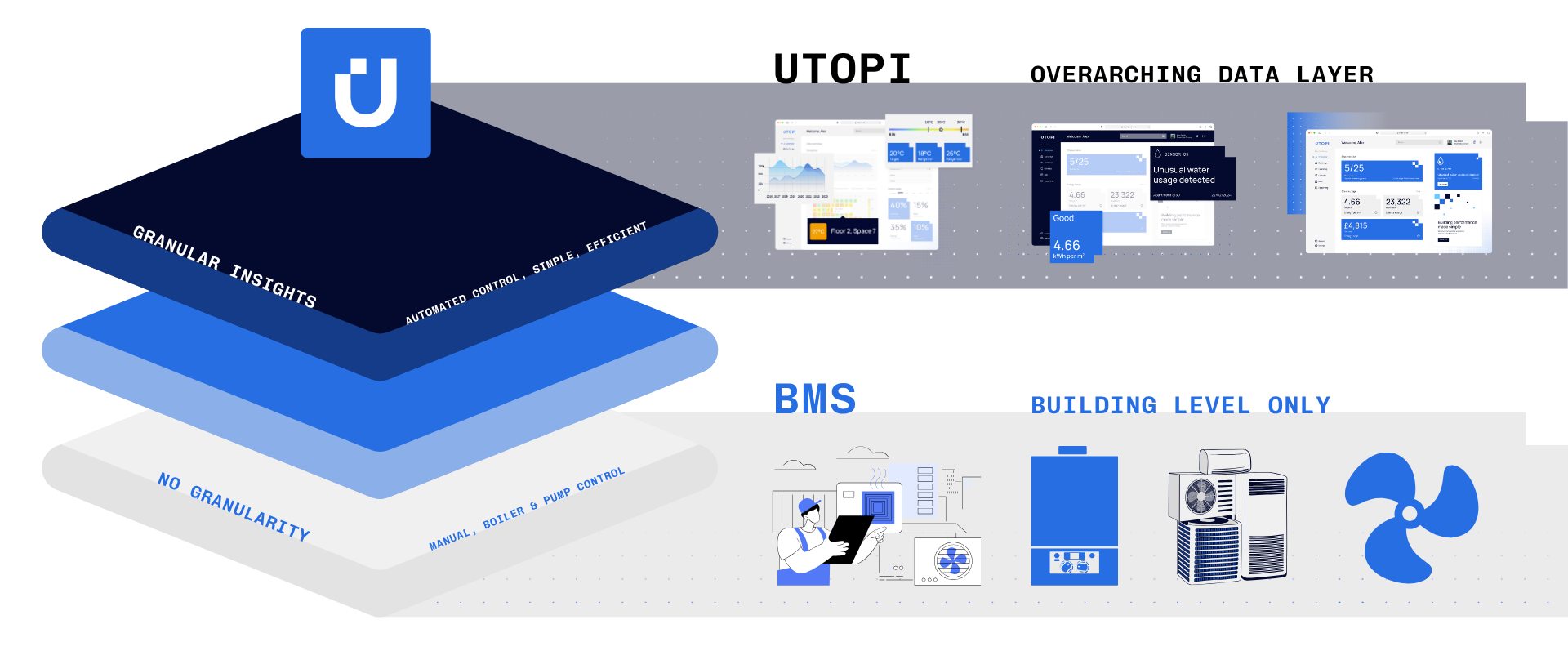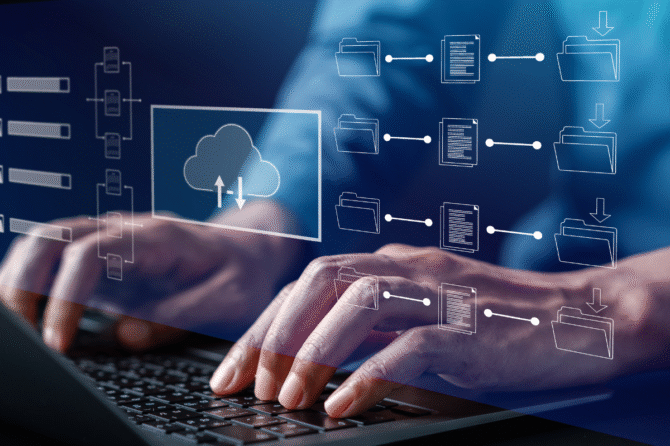
In the world of building performance management, data is power — but not all systems are built to deliver it equally. Traditional Building Management Systems (BMS) were designed to control critical infrastructure like HVAC, lighting, and access systems. Yet, when it comes to delivering rich, granular insight at the room or occupant level, they routinely fall short… and it feels important to note here, from the outset, this is primarily due to cost. To have a BMS that would be fit for purpose for a high-end office building, it would really affect the bottom line but perhaps stack up long term. For a residential property however, those costs don’t always make sense.
That’s where Utopi comes in — a platform designed not to replace a BMS, but to sit above it, enriching it with clean, contextual, and actionable data. The result? Facilities teams, energy managers, and asset owners can finally see, understand, and act on the real-time performance of their assets with unmatched precision.
Traditional BMS: Power at the Core, Blind at the Edge.
Traditional BMS are excellent at managing what happens at the core: boiler control, pump circulation, flow and return temperature monitoring, perhaps zone-level loop valves. But their visibility fades quickly the closer you get to the occupant level.
Typical limitations include:
- Cost and value engineering: While total visibility is technically possible, it is prohibitively expensive and unless a client absolutely insists on it during construction, extensive sensor deployment is not even considered or value engineered out. Costs not only include the sensor hardware but also cabling (many sensors are cabled in to allow the infrastructure to work its magic following installation and commissioning) and BMS licensing cost (typically per data point).
- Lack of granularity: A BMS may “see” a temperature loop per floor, but not per room or per occupant zone.
- Usability: BMS’s are built by engineers, for engineers – rather than operational staff, restricted in access (often specific terminals or panels in plant rooms) rather than PC access through a web interface, data is presented, but not interpreted or contextualised.
- Manual configuration requirements when retrofitted: Integrating new sensors or devices often demands expensive reprogramming and custom logic scripting.
- Siloed data: Even when sensor data exists, it’s often stuck in vendor-specific interfaces, making analysis, benchmarking, or reporting tedious or impossible.
- Minimal insight: Raw temperature or runtime data is rarely translated into actionable insights like “Room 215 overheats daily by 2°C” or “40% of energy used during unoccupied hours.”
This creates a reality where building operators have expensive control systems but little actual understanding of how efficiently (or inefficiently) their spaces are being used and heated.
Utopi: A Clean Data Layer That Connects, Enriches, and Empowers.
Utopi addresses this head-on by serving as a clean data layer that sits above existing systems. It’s not just a device network or a visualisation tool — it’s a full-stack platform that:
- Connects to a wide range of sensors and control devices,
- Normalises and enriches the data with contextual metadata (room, zone, usage),
- Surfaces that data in intuitive dashboards and insight modules,
- Enables automation or optimised decision-making without needing deep engineering intervention.
Key Differentiators of Utopi:

Case Study: Smart TRVs and Wet Heating Systems.
To illustrate the difference between Utopi and traditional BMS systems, consider a typical wet radiator heating system commonly found in residential or student accommodation blocks.
The Traditional Setup –
The system comprises:
- A BMS controlling boilers and pumps, based on temperature deltas.
- Basic flow and return sensors that tell the BMS when water is hot and whether it’s circulating.
- Room radiators controlled by manual TRVs — turned up or down by individual occupants.
The BMS only knows what’s happening at the loop level. It might turn off the boiler when return water gets too hot, but it keeps circulating hot water regardless of whether individual rooms are calling for heat or not. There’s no room-level feedback, no understanding of occupancy, and no insight into misuse or inefficiencies.
The Utopi Upgrade –
Now introduce Utopi’s ecosystem:
- Smart TRVs communicate valve position and desired temperature settings every 15 minutes.
- Multisensors track room occupancy, feeding real-time usage data into Utopi.
- Utopi publishes data via MQTT, enabling optional BMS interaction. Such as, potentially switching off the heating system pumps if there is no ‘call’ or demand for heat.
- All data flows into the Utopi platform, where room-level heating demand, occupancy behavior, and asset usage are clearly visualised.
From this data, Utopi can:
- Identify rooms wasting energy (e.g. radiators on in unoccupied spaces),
- Quantify savings from stepdown logic (reduced heating when rooms are vacant),
- Offer real-time alerts for faults or irregularities (e.g. a TRV stuck open),
- Enable automated boiler/pump control decisions based on actual room-level demand.
And all of this happens without requiring the BMS to be reconfigured.
From Device Status to Business Intelligence.
Here’s how Utopi transforms what would be raw technical data into meaningful insight:

Facilities teams using Utopi can gain tangible value from better data:
- Reduce unnecessary energy consumption by 20–40% through stepdown logic and demand-led control,
- Pinpoint individual underperforming radiators or valves with real data,
- Improve occupant comfort by avoiding under or over-heating,
- Simplify compliance reporting and ESG disclosures with automatic per-room energy tracking,
- Build a digital twin of the building for performance benchmarking and future upgrades.
The future of building management is not just about control — it’s about clarity and action. Utopi empowers owners and operators to go beyond the limitations of legacy BMS systems and see exactly how their spaces behave, where energy is wasted, and where interventions will have the most impact.
By providing a clean, enriched, and granular data layer, Utopi doesn’t just enhance BMS — it liberates building intelligence from technical silos and places it in the hands of decision-makers. And in systems like smart TRVs and wet heating, it proves the model: clear insight, better control, and measurable results.
